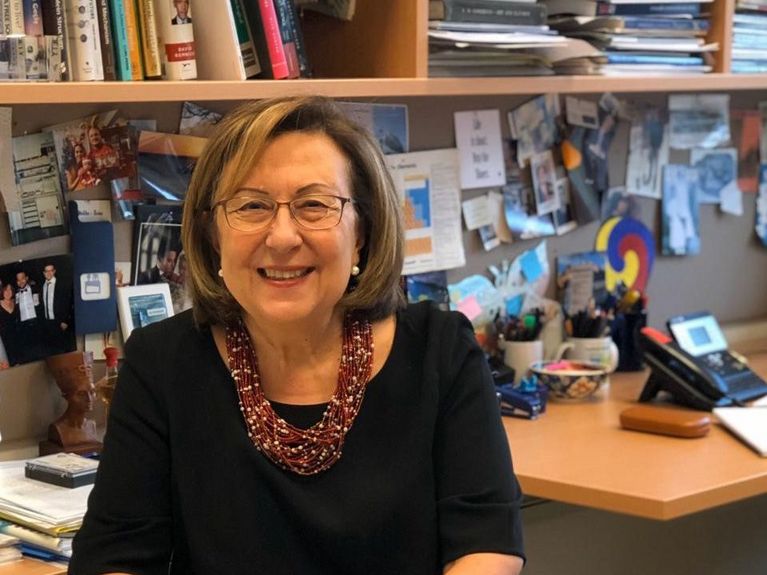Interview
"Science Diplomacy needs Excellent Science"

Zehra Sayers is a biophysicist whose research is mainly in the field of X-ray structural analysis of biomolecules. She was Iterims President of Sabancı University in Istanbul and Co-Chair of the Scientific Advisory Committee of SESAME (Synchrotron-light and Experimental Science and Applications in the Middle East). Since October 2022, she has been a member of the Strategic Advisory Board of the Research Field Matter of the Helmholtz Association. Credit:private
Zehra Sayers was co-chair of the Scientific Advisory Board of the SESAME synchrotron accelerator in Jordan. In this interview, she talks about the vision, successes and obstacles of the project.
Ms. Sayers, what is special about SESAME?
SESAME is an interdisciplinary research center and was opened in 2017. In addition to Jordan, Bahrain, Egypt, Iran, Israel, Pakistan, the Palestinian Authority, Turkey and Cyprus were involved in its establishment. SESAME's mission is to bring world-class science to the Middle East.
SESAME is the first international research laboratory in the Middle East. How do you see its role?
SESAME sees itself as a pioneer of science diplomacy, and science diplomacy needs excellent science. We want to establish technological infrastructure in the region. We want to get researchers from different political and ethnic backgrounds to do research together under one roof. And we want to reverse the brain drain from the Middle East: People should come here to do research instead of leaving.
You yourself have a British-Turkish background. What role does multiculturalism play for you at SESAME?
A big one. Our scientists come not only from the founding member states, but from many countries around the world. Our current research director, for example, is Italian.
Researchers from Israel and Iran work together at SESAME. That is probably unique in this form. How is the collaboration organized?
Credit: Arthur Tainturier / Helmholtz
Mutual respect among different cultural backgrounds is a basic rule. How someone dresses or how someone prays is irrelevant. Anyone seeking spiritual peace will find a space for it.
Do you see yourself as a "role model" for Israeli-Arab cooperation in the region?
We try to do the job that the West-Eastern Diwan Orchestra does in Berlin. As in music, the boundaries between people and cultures are disappearing in science.
What are you researching at SESAME?
SESAME is a user facility. This means that our engineers at the beamlines are service providers. They enable scientists from different disciplines to study material structures without destroying them.
How does it work?
Synchrotron radiation is primarily used to determine the structure, composition and physicochemical functionality of an object. The radiation generated in the ring accelerator is directed at the object, and the absorption or scattering of the radiation can then be used to determine, for example, what the object is made of. Whether one can determine the composition of the objects depends primarily on how much material of it is present. For example, with infrared spectroscopy, we can tell where certain traces on the object under study came from, such as the food people ate, whether they lived near a silver or copper mine, whether they suffered from certain diseases, what the climatic conditions were like, etc.
What kind of objects do you typically study at SESAME?
They are archaeological, for example, and they are works of art as well as everyday objects, and other materials or matter samples. Pieces of hair from ancient graves, teeth and bones, but also old manuscripts. Recently, for example, researchers from Iran and France analyzed ancient Koran manuscripts; the results of their research are currently being published.
What was the oldest object so far?
The oldest object we have studied so far at SESAME is the skin of a mummified Egyptian head, dated to around 1,500 to 1,470 BC.
What disciplines do the researchers conducting investigations at SESAME come from?
For the current round of operations at SESAME, 31 projects have been accepted from the physical and earth sciences, nine from the life sciences, ten from archaeology, and nine from chemistry.
Regarding climate change: Is there also research on environmental conditions at SESAME?
Researchers in front of an experimental facility at SESAME. Credit: private
We are currently investigating contamination of the soil in the Jordan Valley by heavy metals that are harmful to health. In my special field, biology, we are investigating the hitherto unknown functioning of medicinal plants from the region by studying their cellular structure.
We live in politically troubled times. What difficulties are you struggling with?
We try to block out the political; we close the door and leave politics outside. The fact that Iran cannot currently pay its dues because of the sanctions is a problem. For example, we lack sufficient funds to operate the HESEB beamline (the Helmholtz-SESAME soft x-ray beamline HESEB, built by the Helmholtz Association and a number of its research centers) and also for spare parts.
How could Germany help SESAME?
We need more scientists from Europe at SESAME. This year we had an intern from Hamburg there for the first time. That's great, we would like to expand that, also with the help of the Helmholtz Association. We know of a group of archaeologists in Berlin who would like to come to SESAME. We need scientists and interns who want to work here with us.
If you had one wish, what would it be?
About 1,000 users are registered at SESAME, but only 15 can do research with us at the same time. We would like to increase this number, preferably to one hundred. To achieve that, our budget would have to double from the current $6 million.
Professor Zayers, thank you very much for this interview!
Readers comments